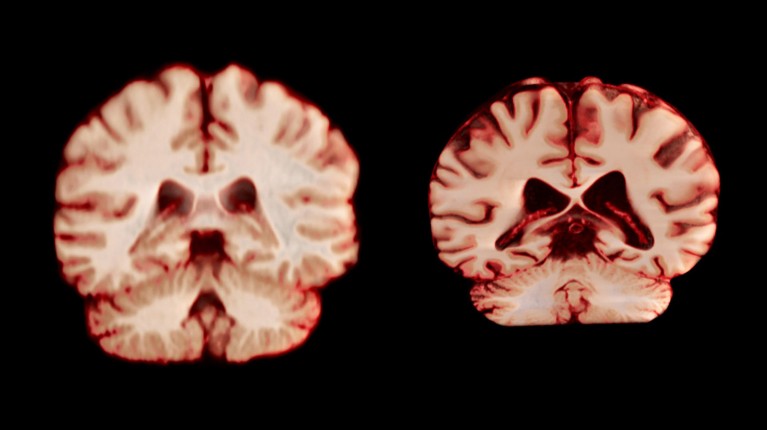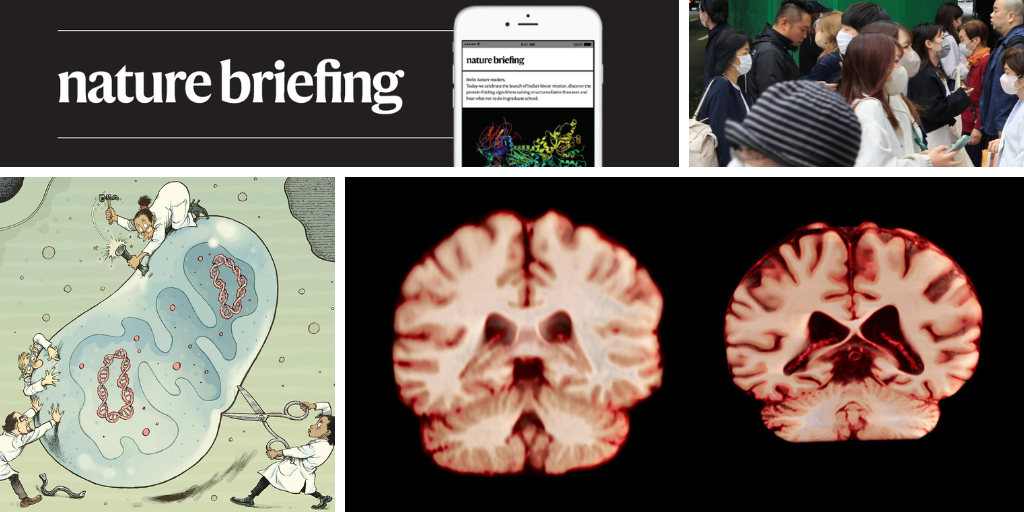You have full access to this article via your institution.
Hello Nature readers, would you like to get this Briefing in your inbox free every day? Sign up here.

A healthy brain (left) and a brain affected by Alzheimer’s disease. Credit: Anatomical Travelogue/SPL
Men’s brains shrink more as they age than women’s brains do, which could scupper the theory that age-related brain changes explain why women are more frequently diagnosed with Alzheimer’s disease than men. Using more than 12,500 brain scans from 4,726 people, researchers found that men experienced a greater reduction in volume across more regions of the brain over time than women did. This suggests that sex differences in brain volume don’t play a part in the development of Alzheimer’s, but “just looking at age-related changes in brain atrophy is unlikely to explain the complexities behind [the disease]”, says clinical neuropsychologist Fiona Kumfor.
Reference: Proceedings of the National Academy of Sciences paper
Japan’s health authorities have declared an influenza epidemic, with thousands of people infected and more than 100 schools closed. The early spike in flu cases could seed outbreaks in other countries that are heading into winter, say researchers. But it is unlikely to become a global pandemic, because countries in the Southern Hemisphere are now entering warmer seasons, when viral spread is reduced.
Researchers engineered lab-cultured cells to readily express olfactory receptors (ORs), the proteins on nasal neurons that respond to odour molecules. The method allowed the team to identify specific ORs and match some of them with the molecules they respond to. This technique could make studying the enigmatic science of smell much easier, but the findings that odorants preferentially activate a particular OR call the idea of combinational coding — a Nobel-winning hypothesis that suggests multiple ORs detect different parts of an odour molecule to create patterns recognized by the brain — into question.
Reference: Current Biology paper
Features & opinion
To understand certain genetic diseases, researchers need to get at the DNA in mitochondria — the powerhouses of cells. Encased in a double membrane, mitochondrial DNA (mtDNA) is inaccessible to CRISPR–Cas9 gene-editing technologies, so researchers have been searching for other ways in. Now, they’ve developed two bacterially derived tools that can edit certain mtDNA bases. These tools are still a way off from clinical use, but the ability to edit mtDNA is already helping researchers to build animal models of mitochondrial disease and answer basic questions about mitochondrial biology.
The sterile nature of modern architecture offers a certain amount of protection from infectious diseases. But some scientists think that it can have some downsides, denying us exposure to microbes that are benign or even beneficial. Architects and microbiologists are exploring whether ‘probiotic’ buildings, sporting microbe-friendly materials such as unvarnished wood and green walls, could help bolster health. But the transfer of microbes from the environment to people, and their ultimate effects, is extremely challenging to study.
This editorially independent article is part of Nature Outlook: The human microbiome, a supplement produced with financial support from Yakult.
In a quarry in Oxfordshire, United Kingdom, palaeontologists have unearthed a dinosaur ‘superhighway’ — a 220-metre-long continuous trail of footprints that are around 166 million years old. The prints, probably made by a sauntering Cetiosaurus, give researchers a glimpse into the life of a dinosaur that they can’t get from fossils alone. “With a trackway like this, we’ve got hundreds of metres of the animal doing its own thing,” says palaeontologist Peter Falkingham. Falkingham has built a 3D recreation of the sauropod in motion that you can follow along with in this animation-packed feature.
Happy Ada Lovelace Day! This year, I’m channelling my inner computer scientist by brushing up on my coding skills and learning, for the first time, a bit of Python. If you fancy taking on the challenge but you’re not sure where to start, we’ve got you: start with Nature’s guide to which programming language will suit you and your science best.
Let me know how you’re celebrating Lovelace Day and the achievements of women in science, technology, engineering and maths — plus any feedback on this newsletter — at [email protected].
Thanks for reading,
Flora Graham, senior editor, Nature Briefing
With contributions by Jacob Smith
• Nature Briefing: Careers — insights, advice and award-winning journalism to help you optimize your working life
• Nature Briefing: Microbiology — the most abundant living entities on our planet — microorganisms — and the role they play in health, the environment and food systems
• Nature Briefing: Anthropocene — climate change, biodiversity, sustainability and geoengineering
• Nature Briefing: AI & Robotics — 100% written by humans, of course
• Nature Briefing: Cancer — a weekly newsletter written with cancer researchers in mind
• Nature Briefing: Translational Research — covers biotechnology, drug discovery and pharma


